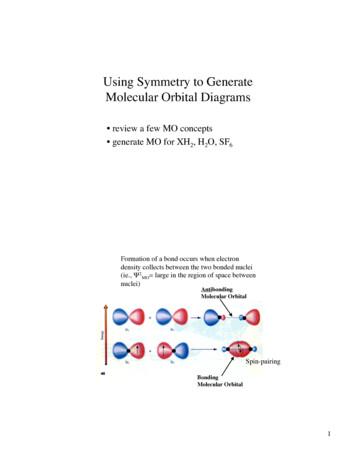Using Symmetry To Generate Molecular Orbital Diagrams
Using Symmetry to GenerateMolecular Orbital Diagrams review a few MO concepts generate MO for XH2, H2O, SF6Formation of a bond occurs when electrondensity collects between the two bonded nuclei(ie., Ψ2 MO large in the region of space betweennuclei)AntibondingMolecular OrbitalSpin-pairingBondingMolecular Orbital1
. the valence electrons draw the atomstogether until the core electrons start to repelone other, and that dominates2
the total number of molecular orbitals (MO’s)generated total number of atomic orbitals(AO’s) combinedAtom AAtom B (4 AO’s)(4 AO’s)Molecule A–B(8 MO’s)in order to overlap .Atom A(4 AO’s) Atom B(4 AO’s)AO’s must have: similar energies identical symmetriesMolecule A–B(8 MO’s)3
Atom AAtom B σ–bonddoesn’t change signupon rotation aboutinternuclear axis Atom AAtom B σ –bond (antibond)σ since still doesn’t change sign uponrotation about internuclear axis Atom AAtom B σ–bonddoesn’t change signupon rotation aboutinternuclear axis Atom AAtom B σ –bond (antibond)antibonding since changes sign uponrotation about axis perpendicular tointernuclear axis4
Atom A Atom Bπ–bondchanges signupon rotation aboutinternuclear axis Atom A Atom B π –bond (antibond)π since still changes sign uponrotation about internuclear axisantibonding since changes sign uponrotation about axis perpendicular tointernuclear axis5
Additional orbital labels, used by your book,describe orbital symmetry with respect to inversion (x,y,z)i (–x,–y,–z)inversion centerAdditional orbital labels, used by your book,describe orbital symmetry with respect to inversioni g gerade, if orbital does notchange phase upon inversionπg*i u ungerade, if orbital doeschange phase upon inversionπu6
Additional orbital labels, used by your book,describe orbital symmetry with respect to inversioni g gerade, if orbital does notchange phase upon inversionσgi u ungerade, if orbital doeschange phase upon inversionσu*the amount of stabilization and destabilization which resultsfrom orbital overlap depends on the type of orbital MOΔΕstab(s-orbital) ΔΕstab(p-orbital)7
the amount of stabilization and destabilization which resultsfrom orbital overlap depends on the type of orbital MOΔΕstab(p-orbital) ΔΕstab(d-orbital)With p-orbitals need to consider two typesof overlap, sigma (σ) and pi ) ΔΕstab(pi)8
Sigma overlap is betterΔstab(sigma) Δstab(pi)One also needs to consider energy matchAOAOAO!Estab(better E match)AO!Estab(poor E match)AOs are closerin energyAOs are furtherapart in energyΔΕstab(better E match) ΔΕstab (poor E match)9
Molecular Orbital Diagramsof more complicated moleculesXH2 (D h )H2O (C2v)SF6 (Oh)XH2 (D h) lineargeneral MOdiagram layouta linear combinationof symmetry adaptedatomic orbitals (LGO’s)correlationlinescentral atom’s (X ‘s)atomic orbitalsH––X––Hmolecular orbitalsatomic orbitalsof terminal atomsH1 H210
a linear combination of symmetry adaptedatomic orbitals (LGO’s) .Taken individually, the hydrogenatoms do not possess thesymmetry properties of theXH2 molecule. Taken as agroup they do, however.LGO (2)H1 –H2LGO (1)H1 what does this mean ?H2atomic orbitalsof terminal atomsH1 H2What are the symmetry properties of this molecule?There are an infinitenumber of theseC2C2H––X––HC .and an infinite numberof mirror planes perpendicularto the C axis, which containthe C2’s.11
Taken individually, this hydrogenatom does not possess C2 symmetryabout axes that are perpendicularto the C .C2H––XC2C Thus, the individualhydrogen atoms do not conformto the molecular D h symmetry.s-orbital symmetry labelXH2’s point groupsymmetry label given toidentify the pz orbitalatom X’s pzof atom X (central atom) atomic orbitals C21–1atom X’s px andpy atomic orbitalssymmetry label given toidentify the px and py orbitalsof atom X (central atom)atom X’ss–orbital12
We can perform symmetry operations on orbitalsas well as molecules We can perform symmetry operations on orbitalsas well as molecules the rows of numbers that follow each orbitals symmetrylabel tell us how that orbital behaves when operated uponby each symmetry element13
C21–1 We can perform symmetry operations on orbitalsas well as molecules the rows of numbers that follow each orbitals symmetrylabel tell us how that orbital behaves when operated uponby each symmetry element a “1” means that the orbital is unchanged by the symmetryoperation a “–1” means that the orbital changes phase as a result ofthe symmetry operation a “0” means that the orbital changes in some other wayas a result of the symmetry operation a “cos θ” occurs with degenerate sets of orbitals (eg. (px, px))that take on partial character of one another upon performanceof a symmetry operation14
s-orbitalC2C2C rotation about the C ,and C2 axes leaves thes–orbital unchangedthus the “1” character in the row highlighted forthe s-orbital, and under the columns headed C ,and C2 C21–115
on the other hand, the pz orbital changesphase upon rotation about any of the C2 axes C21–1rotation about the C2axis changes the phaseof the pz orbital pz–orbitalpz-orbitalC2C2C rotation about the C axis leaves thepz–orbital unchanged16
but a 1 “plus one” under the column headed C C21–1thus the “–1” (negative one) characterin the column headed C2When the px and py are rotated about the C axis,they move, rather than transform into themselves C21–1Thus the “0” in the column labeled 2C 17
inversion, on the other hand, causes both the px andpy to change phase C21–1Thus the “–2” in the column labeled iThe “–2” indicates that both orbitals transform as a setRotation about the C axis moves thepx–orbitalinto a position where it nolonger looks like a px orbitalthe orbitals are definedin terms of a fixed coordinatesystemx-axispx-orbitaly-axisC2HThe z-axis is selected so thatit either coincides with thehighest-fold rotation axis,or the internuclear axis, or bothXC2Hz-axis C For all C2’s except those thatcoincide with the x- and y-axes,rotation about C2causes the px –orbital to takeon some py –orbital character18
Rotation about the C2’s that do not coincide with thex- or y-axes, causes the px–orbital to take onsome py –orbital characterx-axisC2px-orbitalHXHy-axisz-axis C In fact, rotation about the C2 axis that bisectsthe x- and y-axes converts the px–orbital intothe py –orbital. This indicates that these two orbitalsmust be degenerate (ie have identicalenergies) C21–1Thus the “cos φ” term in the column labeled C219
The number in the “E”column tells you howmany orbitals transformtogether as a setinversion, on the other hand, causes boththe px and py to change phase, butmaintain their identities C21–1Thus the “–2” in the column labeled iThe “–2” indicates that both orbitals transform as a setx-axispx-orbitaly-axis inversioncenter, iz-axisinversion thru ichanges the phase of thepx–orbital20
Thus, we have determined the symmetry labels,labels,generally referred to as Mulliken symbols,symbols, forthe s and pz, px,and py-orbitalson the central atom XXH2 (D h )This explains the labels shown forthe central atom X on the leftpza1u(σu)pxpye1u (πu)2sa1g (σg)central atom’s (X ‘s)atomic orbitals21
We determine the symmetry labels for the LGO’s in thesame manner, ie., by examining their symmetry withrespect to the symmetry operations of the D h point groupLGO (2)H1 –H2LGO (1)H1 H2rotation about the C2axes changes the phaseof LGO(2)LGO(2)C2C2C rotation about the C axis leaves LGO(2)unchanged22
.thus it appears that LGO(2) possesses a1usymmetry C21–1 . symmetry identical to that of the central atomX’s pz orbitalXH2 (D h)py px .thus, the symmetry of LGO(2)matches that of the X atom’s pz–orbitalpze1u (πu) a1u(σu)LGO (2) .this interaction issymmetry alloweda1u (σu)LGO (1)2sa1g (σg)central atom’s (X ‘s)atomic orbitals .and LGO(2) will combinewith the X pz–orbital to forma new molecular orbital (MO)atomic orbitalsof terminal atomsH1 H223
rotation about the C2axes leaves LGO(1)unchangedLGO(1)C2C2C rotation about the C axis leaves LGO(1)unchangedOr . .thus it appears that LGO(1) could possess eithera1g , or a2u symmetry C21–1 . a1g would match orbitalson atom X, whereas a2u would not.24
if we examine the symmetry of LGO(1) with respect to bothinversion, and reflection, we should be able to distinguish betweenthese two options C21–1rotation about the C axes leaves LGO(1)unchangedLGO(1)C Reflection thru mirror planePerpendicular to C leavesLGO(1) unchanged25
thus, we can rule out a2u as the symmetry assignment forLGO(1), based on reflection, and improper rotation C21–1inversion leaves LGO(1)unchangedLGO(1)inversioncenter, i 26
thus, we can rule out a1u , and a2u as thesymmetry assignment for LGO(1) C21–1 leaving a1g as the symmetry assignment for LGO(1)XH2 (D h)pz px pye1u (πu)a1u(σu)2sa1g (σg)central atom’s (X ‘s)atomic orbitals .thus, the symmetry of LGO(1)matches that of the X atom’ss–orbitalLGO (2)a1u (σu)a1g (σg)LGO (1)atomic orbitalsof terminal atomsH1 H227
XH2 (D h)pz px pye1u (πu)a1u(σu) .inserting our correlation linesbetween orbitals of the same symmetrya1u * (σu *)a1g* (σg *)e1u (πu)nonbondingLGO (2)a1u (σu)a1g (σg)2sa1g (σg)LGO (1)a1u (σu)central atom’s (X ‘s)atomic orbitalsa1g (σg)atomic orbitalsof terminal atomsH1 H228
’s point group atom X’s p x and p y atomic orbitals symmetry label given to identify the p x and p y orbitals of atom X (central atom) symmetry label given to identify the p z orbital of atom X (central atom) atom X’s p z atomic orbitals atom X’s s–orbital s-orbital symmetry label C 2 1 –1
SEMESTER I Paper I Molecular Symmetry and Molecular Vibrations 1. Molecular Symmetry: a) Symmetry elements and symmetry operations with special reference to water, ammonia and ethane. b) Classification of molecules/ ions based on their symmetry properties. c) Derivation of matrices for rotation, reflection, rotation-reflection and .
Symmetry Point Groups Symmetry of a molecule located on symmetry axes, cut by planes of symmetry, or centered at an inversion center is known as point symmetry . Collections of symmetry operations constitute mathematical groups . Each symmetry point group has a particular designation. Cn, C nh, C nv Dn, D nh, D nd S2n C v ,D h
1/2 13: Symmetry 13.1 Line symmetry and rotational symmetry 4 To recognise shapes that have reflective symmetry To draw lines of symmetry on a shape To recognise shapes that have rotational symmetry To find the order of rotational symmetry for a shape 13.2 Reflections To
Symmetry IQ 3000 unit (230V) uK uP3-230uK Symmetry IQ 3000 unit (230V) australia uP3-230au Symmetry IQ 4000 unit (120V) uP4-120 Symmetry IQ 4000 unit (230V) eu uP4-230eu Symmetry IQ 4000 unit (230V) uK uP4-230uK Symmetry IQ 4000 unit (230V) australia uP4-230au Symmetry IQ 2000 Integrated unit uP2 handpiece lux uPhPl hF-475/0611 hu-Friedy mfg .
Chemistry of the following metals: (a) Li, Be, Ra (b) Sn, Pb. 4. Chemistry of halogens with reference of extraction, oxidation states and halides. GROUP-C: MISCELLANEOUS TOPICS 1. (a) Molecular Symmetry: An Introduction: Symmetry elements and symmetry operations, centre of symmetry, axis of symmetry and plane of symmetry (definitions). (b) Elementary Magnetochemistry: Types of magnetic .
Computational Mechanics, AAU, Esbjerg ANSYS Symmetry One of the most powerful means of reducing the size of a FEA problem is the exploitation of symmetry Symmetry is said to exist if there is a complete symmetry of geometry, loads and constraints about a line or plane of symmetry When exploiting symmetry model needs to be
only line symmetry only rotational symmetry both line symmetry and rotational symmetry neither line symmetry and nor rotational symmetry 30 . These printable Worksheets and Practice Papers are available for FREE download Helps stu
Symmetry is one of the fundamental concepts in Geometry. It is important to learn about symmetry by . used flags from different countries to present the concept of symmetry, which approach connects . line symmetry and point symmetry. - Every student tries to find sy























